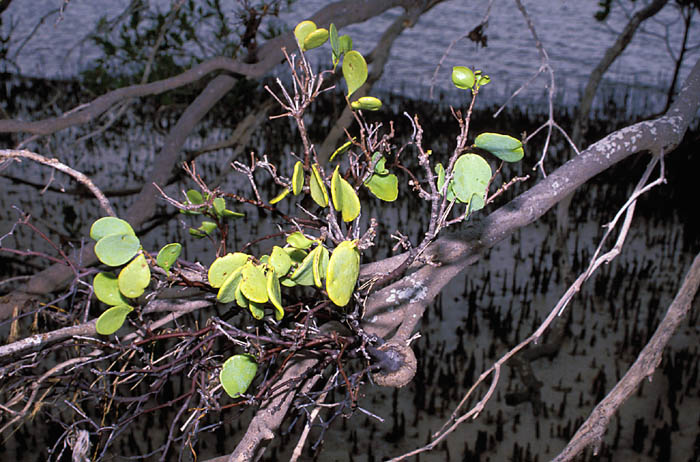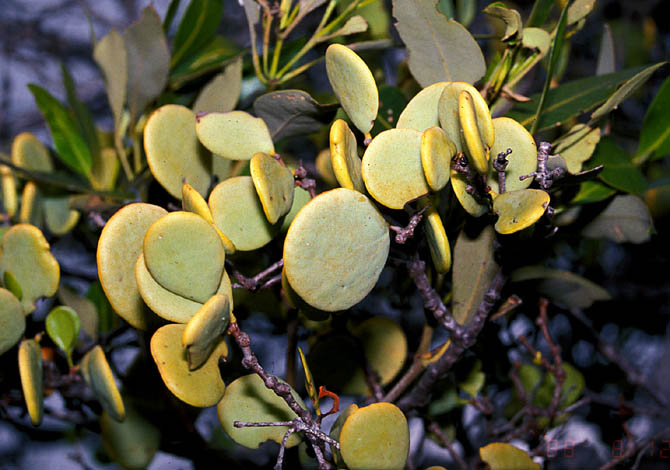
Distribution Map

Description (Barlow 1992)
Loranthus mackayensis Blakely, Proc. Linn. Soc.New S. Wales 47 (1922) 392; ibid. 48 (1923) 131. -Amyema mackayensis (Blakely) Danser, Bull. Jard. Bot. Buitenzorg III, 10 (1929) 297. Type: Tryon s.n. (holo NSW), Queensland, Mackay.
Loranthus cycneus-sinus Blakely, Proc. Linn. Soc. New S.
Wales 47 (1922) 392; ibid. 48 (1923) 131. -Amyema mackayensis
subsp. cycnei-sinus (Blakely) Barlow, Austral. J. Bot.
14-(1966) 472. - Type: Fitzgerald 1705 (holo NSW; iso PERTH),
Western Australia, West Kimberley, Cygnet Bay, xi.1906.
For descriptions and additional synonymy see Barlow, Austral. J. Bot 22 (1974) 580; Flora of Australia 22 (1984) 96. Amyema mackayensis has few specialized characters, and thus presents a relatively generalized facies for the genus. The species can be identified locally by its combination of glabrous habit, shortly petiolate elliptic to orbicular leaves 2-6 cm long, few-rayed umbel of triads with the central flower sessile, and corolla lacking longitudinal ridges in bud. The species is also identified by its habitat and host specialization (see below). Flower colour is red, yellow, or green, sometimes grading from red in the lower part to paler hues above.
The species occurs in New Guinea and northern Australia (fig.
10), exclusively in mangrove communities, and is recorded as parasitic
on Avicennia, Camptostemon, Ceriops, Excoecaria, Lwnnitzera,
Rhizophora, and Sonneratia. It shows features common
in Australian amyemas of open forests and woodlands (even in New
Guinea), including a lack of epicortical runners, leaves which
are curvinerved and isobilateral, and few-rayed inflorescences.
Its habitat and host specialization are correlated with the relatively
small rounded leaves which are usually very thick and fleshy when
fresh. The species therefore often shows a close visual resemblance
to its host (Barlow & Wiens, 1977).
Two subspecies were recognized by Barlow (1966), based on Blakely's
Loranthus mackayensis and L. cycneus-sinus, from
northeastern and northwestern Australia respectively. The two
subspecies have very minor differences in inflorescence and flower
dimensions, and these differences are weakened by the intermediate
nature of the specimens from Torres Strait and southern New Guinea.
Amyema mackayensis is best treated as a species without
designated subspecies but with some minor local variation in inflorescence
dimensions.
In northwestern Australia Amyema mackayensis is sympatric
with A. thalassia, which is also specialized for mangrove
hosts. The latter species differs in its longitudinally winged
rays, pedicels and corolla buds, and in its 4-merous flowers.
See note under A. gravis on similarities and relatonships.
Description (Barlow 1974)
Amyema mackayense (Blakely) Dans. Bull. Jard. bot. Buitenz. 10: 297 (1929); Barlow, Aust. J. Bot. 14: 471 (1966); Loranthus rnackayensis Blakely, Proc. Linn. Soc. N.S.W. 48: 131, illus. p1. 4 (1923). Type-Mackay, Queensland, Tryon (NSW 54887).
Loranthus cycnei-sinus Blakely, Proc. Linn. Soc. N.S.W. 48: 131, illus. p1. 4 (1923); Amyema cycnei-sinus (Blakely) Dans. Bull. Jard. bot. Buitenz. 10: 295 (1929). Type. Cygnet Bay, West Kimberley, Western Australia, Fitzgerald 1705, Nov. 1906 (Nsw, holotype; PERTH).
Glabrous or the calyx and fruit minutely and sparsely brown-tomentose. Runners absent. Stems smooth, enlarged at the nodes, much-branched. Leaves opposite; petiole distinct, 3-6 mm long; lamina elliptical or ovate to orbicular, 2.5-4-(6) by 1.5-2.5 (4.5) cm, contracted at the base, rounded at the apex; venation obscure, curvinerved. Inflorescences solitary or paired in the axils; peduncle 6-22 mm long; rays (2)-3-4-(5), spreading, 4-10 mm long; pedicels of the lateral flowers of the triads 2-5 mm long; bracts acute to truncate, 1 mm long. Calyx cylindrical to funnel-shaped; limb truncate, 0.5-1 mm long. Corolla in the mature bud slender, clavate, 10-28 mm long. Anthers 1.5-3 mm long; free parts of the filaments 3-5 mm long. Fruit ellipsoidal, crowned by the persistent calyx limb. Chromosome Number.- n = 9 (Barlow 1963, from Australian material).
Amyema mackayense comprises two subspecies, one of which occurs in the area dealt with here.
18a. Subsp. cycnei-sinus (Blakely) Barlow, Aust. J. Bot. 14: 472 (1966); Loranthus cycnei-sinus Blakely, Proc. Linn. Soc. N.S.W. 48: 131, illus. p1. 4 (1923); Amyemacycnei-sinus (Blakely) Dans. Bull. Jard. bot. Buitenz. 10: 295 (1929). Type.-Cygnet Bay, West Kimberley, Western Australia, Fitzgerald 1705, Nov. 1906 (NSW, holotype; PERTH).
Lamina broad spathulate to ovate (to nearly orbicular), 25-4 by 1.5-2 5 cm. Peduncle usually deflexed, 6-15 mm long; rays usually 3, 4-6 mm long; pedicels of the lateral flowers of the triads 2-4 mm long. Calyx funnel-shaped, contracted just below the limb. Corolla 10-16 mm long. Anthers 1 5 mm long.
Occurrence. New Guinea, from the Merauke District, West Irian, to the adjoining part of Western District, Papua (Fig. 6). Also from West Kimberley to Arnhem Land, northern Australia. In coastal communities, parasitic on mangroves,. and recorded on Avicennia in New Guinea.
Specimens Examined. WEST IRIAN: Merauke Dist.,
path from Merau R. to Koembe R., S. of Oeroem Village, 2 m alt.,
van Rayen 4926, 9.ix.1954 (L; CANB). EASTERN
NEW GUINEA Mouth of Bensbach R., Western District, Papua,
15 m alt., Ridsdale NGF 33678, 12.viii.1967 (LAE).
Illustrations
Photographs

Parasitic on Avicennia marina. Queensland, Australia. Photo by Gerhard Glatzel.

Vegetative plant showing succulent, round leaves. Parasitic on Avicennia marina. Queensland, Australia. Photo by Gerhard Glatzel.
updated 18 January 2007